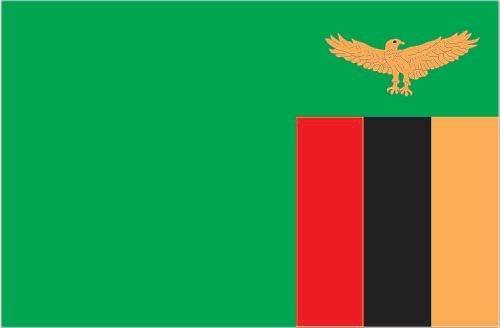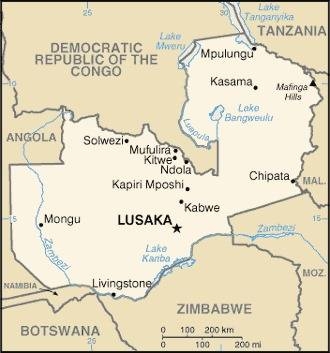229 Zambia

Green field, representing the country’s natural resources and vegetation, with a panel of three vertical bands of red symbolizing the struggle for freedom (hoist side), black representing the people of Zambia, and orange representing the country’s mineral wealth, below a soaring orange eagle, representing the people’s ability to rise above the nation’s problems, on the outer edge of the flag.
Flag courtesy of the CIA World Factbook

Map courtesy of the CIA World Factbook

One of the gorges carved out by Victoria Falls. The local name for the falls is Mosi-oa-Tunya (The Smoke that Thunders).
Photo courtesy of the CIA World Factbook
Government
According to Britannica, Zambia’s initial constitution was abandoned in August 1973 when it became a one-party state. The constitution of the Second Republic provided for a “one-party participatory democracy,” with the United National Independence Party (UNIP) the only legal political party. In response to mounting pressures within the country, the constitution was changed in 1991 to allow the reintroduction of a multiparty system.
Under the terms of the constitution, the president, who is head of state and commander in chief of the armed forces, is elected by universal adult suffrage to no more than 2 5-year terms. He is empowered to appoint the vice president, the chief justice, and members of the High Court on the advice of the Judicial Services Commission. During the president’s absence, his duties are assumed by the vice president. From elected members of the legislature, called the National Assembly, the president also appoints a Cabinet that consists of ministers, deputy ministers, and provincial deputy ministers. In 1996 the government enacted constitutional amendments that barred foreign nationals and those with foreign parentage from running for president, a change that generated heated debate.
Central government is represented throughout Zambia by the provincial government system, by which resident ministers, each of whom is the president’s direct representative, are appointed by the president to each of the provinces. The provinces are divided into districts, each of which has a district council chairman responsible to the provincial deputy minister; the district council chairman is particularly concerned with political and economic developments. His civil service counterpart is the district executive secretary. The cities of Lusaka, Ndola, and Kitwe have councils and mayors, but the formerly separate management of mine townships on the Copperbelt has been abolished.
The court system consists of the Supreme Court, the High Court, subordinate magistrate’s courts, and local courts. Because the law administered by all except the local courts is based on English common law, decisions of the higher British courts are of persuasive value; in fact, a few statutes of the British Parliament that were declared by ordinance (decree) to apply to Zambia are in force so far as circumstances permit. Most of the laws presently on the statute book, however, have been locally enacted by ordinance or, since independence, by Zambian acts.
The Supreme Court consists of the chief justice, deputy chief justice, and several other justices; it is the court of last resort. The High Court is presided over by a chief justice and is basically an appellate court. There are 3 classes of magistrate’s courts, with progressive degrees of criminal and civil jurisdiction. Local courts consist of a president sitting alone or with other members, all appointed by the Judicial Services Commission. Jurisdiction is conferred by the minister of justice and may encompass any written law, but punishment powers are limited. Local courts also deal with civil cases of a customary nature. Customary law is followed when it is not incompatible with other legislation.
The judiciary remains formally independent. The president appoints the chief justice and, on the advice of the Judicial Services Commission, also appoints other judges; however, the constitution severely restricts the president’s powers of dismissal, and on occasion judges have not shrunk from challenging the authority of the government or party. At the same time, the scope of the judiciary was seriously limited by presidential powers of preventive detention under emergency regulations brought in at the time of Rhodesian UDI in November 1965 and subsequently regularly renewed by the National Assembly. The ending of these state-of-emergency regulations on Nov. 8, 1991, was one of the first acts of the new government.
Civil Aviation Authority (CAA)
The Civil Aviation Authority (CAA), was established by Act No. 7 of 2012, as an autonomous aviation regulator. This was in line with international best practice and to enable the creation of an effective safety oversight authority in Zambia. The CAA seeks to provide effective and efficient regulatory services to the aviation industry, ensure legal compliance and provide safety assurance with value for money for all air transport users in Zambia. In its over sight capacity, the CAA is guided by its core values in pursuance of its corporate objectives.
Airspace
SkyVector – Google Maps – ADS-B Exchange
ICAO countries publish an Aeronautical Information Publication (AIP). This document is divided into three parts: General (GEN), En Route (ENR) and Aerodromes (AD). ENR 1.4 details the types of airspace classes they chose to adopt from classes A through G.
Drone Regulations
Advanced Air Mobility (AAM) Regulations & Policies
None found by the author.
However, should you, the reader, happen to stumble across something to the contrary, please email the author at FISHE5CA@erau.edu and you may be mentioned in the ACKNOWLEDGEMENTS section of this book by way of thanks for contributing to this free eBook!
Advanced Air Mobility (AAM) News
None found by the author.
However, should you, the reader, happen to stumble across something to the contrary, please email the author at FISHE5CA@erau.edu and you may be mentioned in the ACKNOWLEDGEMENTS section of this book by way of thanks for contributing to this free eBook!
Short Essay Questions
Scenario-Based Question
You have been hired by a Drone Startup Company. Your boss has immediately assigned this job to you.
They need you to prepare a one-page memo detailing the legalities of using a drone to film The Smoke That Thunders, pictured above.
They need you to mention any national laws and local ordinances.
They specifically want to know what airspace (insert pictures) you will be operating in and whether or not you need an airspace authorization.
Does it matter whether or not you are a citizen of the country?
Lastly, there is a bonus for you if, as you scroll through this chapter, you find any typos or broken links!
Short Essay Questions
- What are the drone categories?
- How is registration addressed?
- How is remote ID addressed?
- What are the model aircraft rules?
- What are the commercial drone rules?
- Are there waivers or exemptions to the rules? If so, for what?
- Would you share a link to an interactive airspace map?
- How is BVLOS addressed?
- How can you fly drones at night?
- How can you fly drones over people?
- Where do you find drone NOTAMs?
- What are the rules for drone maintenance?
- What are the rules for an SMS program?
- What are some unique rules not mentioned above?
- What are the C-UAS rules?
- What are the AAM rules?

